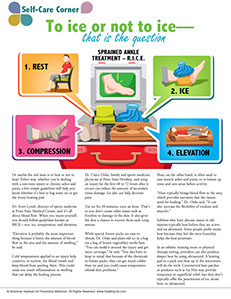SYMPTOM CHECKER
CONDITIONS
Male
Female
Child
Arm, Hand & Shoulder Concerns
Legs & Feet Concerns
Dental & Mouth Concerns
Ear & Nose
Eye Conditions
Head Conditions
Arm, Hand & Shoulder Concerns
Legs & Feet Concerns
Front
Back
Arm, Hand & Shoulder Concerns
Dental & Mouth Concerns
Ear & Nose
Eye Conditions
Head Conditions
Arm, Hand & Shoulder Concerns
Dental & Mouth Concerns
Ear & Nose
Eye Conditions
Head Conditions
Front
Back
Arm, Hand & Shoulder Concerns
Neck Links
Head & Neck Concerns
Arm, Hand & Shoulder Concerns
Neck Links
Head & Neck Concerns
Front
Back
Online Clinic
Wise Healthcare
To ice or not to ice— that is the question
Print on Demand
Or maybe the real issue is to heat or not to heat? Either way, whether you’re dealing with a one-time injury or chronic aches and pains, a few simple guidelines will help you know whether it’s best to bag some ice or get the trusty heating pad.
Dr. Scott Lynch, director of sports medicine at Penn State Medical Center, said it’s all about blood flow. When you injure yourself, you should follow guidelines known as RICE—rest, ice, compression, and elevation.
“Elevation is probably the most important thing because it limits the amount of blood flow to the area and the amount of swelling,” he said.
Cold temperatures applied to an injury help constrict, or narrow, the blood vessels and keep blood from pooling there. This could cause too much inflammation or swelling that can delay the healing process.
Dr. Cayce Onks, family and sports medicine physician at Penn State Hershey, said icing an injury for the first 48 to 72 hours after it occurs can reduce the amount of secondary tissue damage. Ice also can help decrease pain.
Use ice for 20 minutes, once an hour. That’s so you don’t create other issues such as frostbite or damage to the skin. It also gives the skin a chance to recover from each icing session.
While special freezer packs are easy to obtain, Dr. Onks said plain old ice in a bag (or a bag of frozen vegetables) works best. “You can mold it around the injury and get more coverage,” he said. “You also have to keep in mind that because of the chemicals in freezer packs, they can get much colder than ice and you could cause temperature-related skin problems.”
Heat, on the other hand, is often used to ease muscle aches and pains, or to loosen up tense and sore areas before activity.
“Heat typically brings blood flow to the area, which provides nutrients that the tissues need for healing,” Dr. Onks said. “It can also increase the flexibility of tendons and muscles.”
Athletes who have chronic issues or old injuries typically heat before they are active and ice afterward. Some people prefer moist heat because they feel the extra humidity helps the heat penetrate.
In an athletic training room or physical therapy setting, providers can also produce deeper heat by using ultrasound. A heating pad or a pack you heat up in the microwave will do the trick. Commercial heat patches or products such as Icy Hot may provide temporary or superficial relief, but they don’t typically offer the penetration of ice, moist heat, or ultrasound.
This website is not meant to substitute for expert medical advice or treatment. Follow your doctor’s or health care provider’s advice if it differs from what is given in this guide.
The American Institute for Preventive Medicine (AIPM) is not responsible for the availability or content of external sites, nor does AIPM endorse them. Also, it is the responsibility of the user to examine the copyright and licensing restrictions of external pages and to secure all necessary permission.
The content on this website is proprietary. You may not modify, copy, reproduce, republish, upload, post, transmit, or distribute, in any manner, the material on the website without the written permission of AIPM.
2021 © American Institute for Preventive Medicine - All Rights Reserved. Disclaimer | www.HealthyLife.com
















































